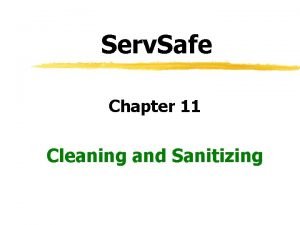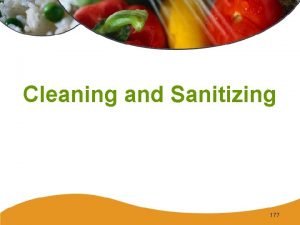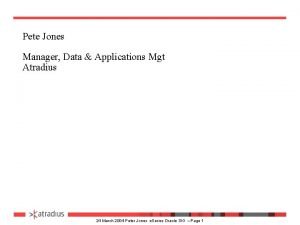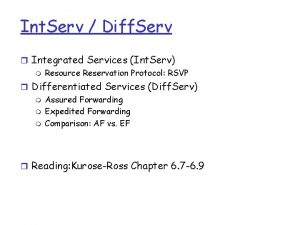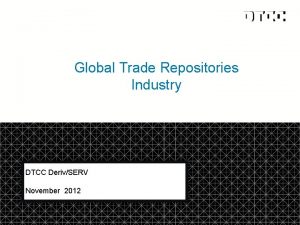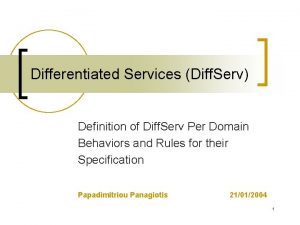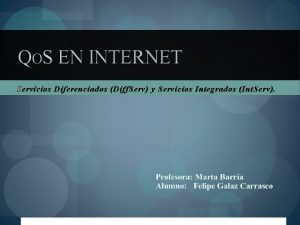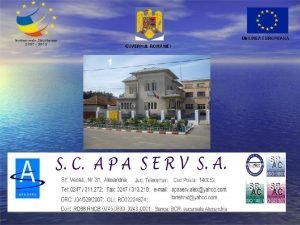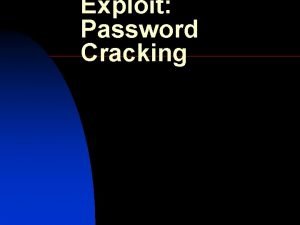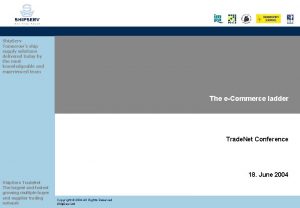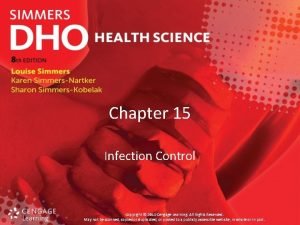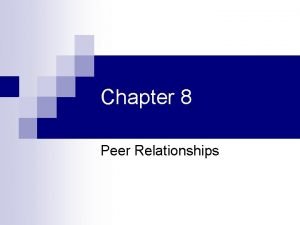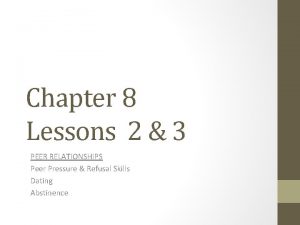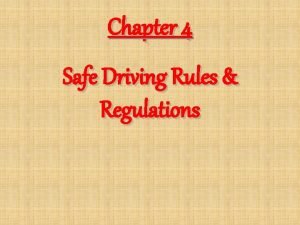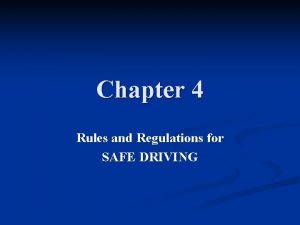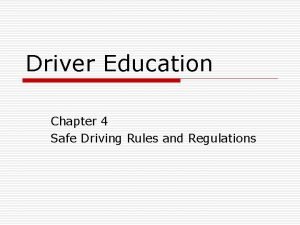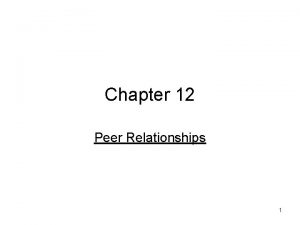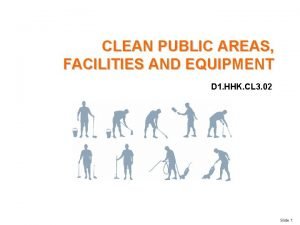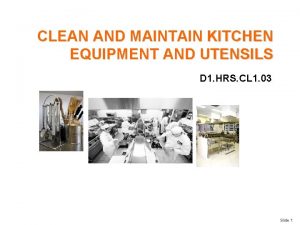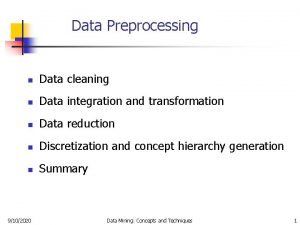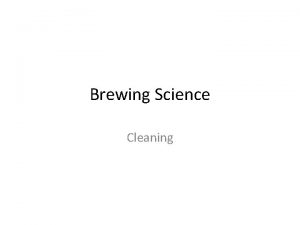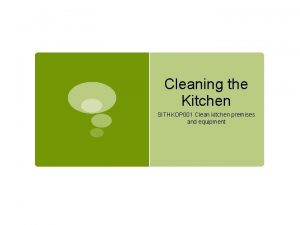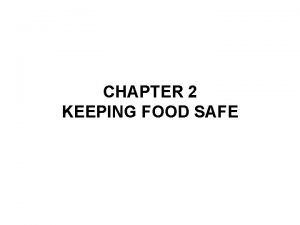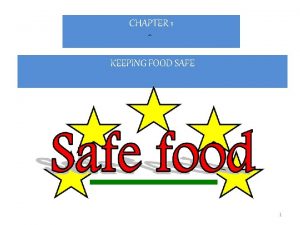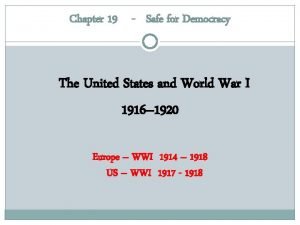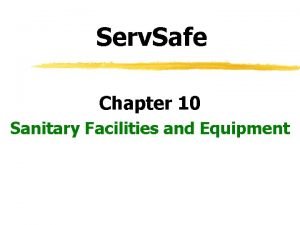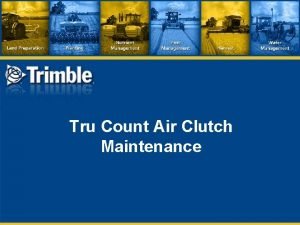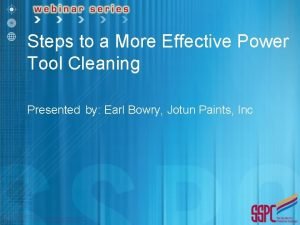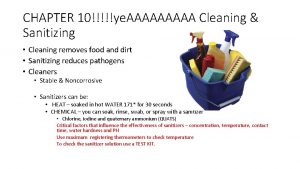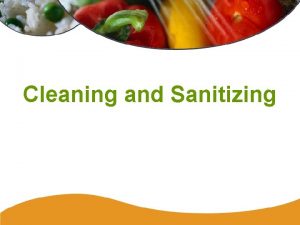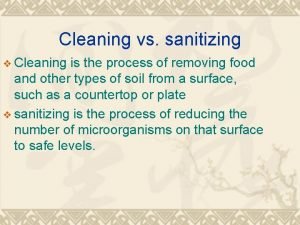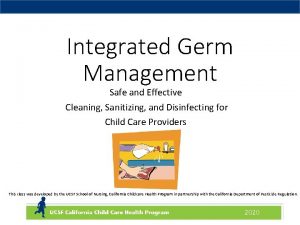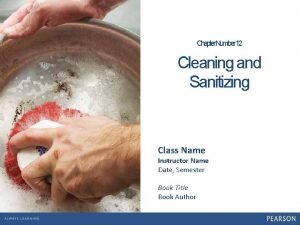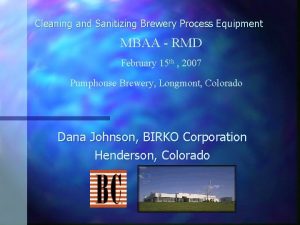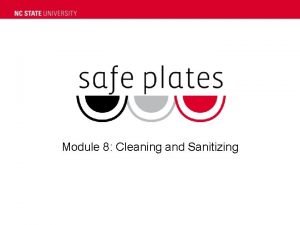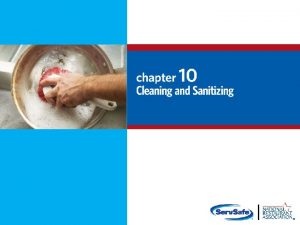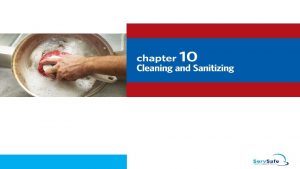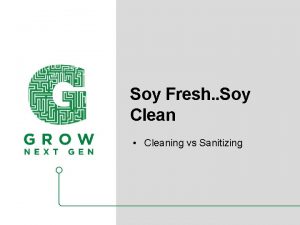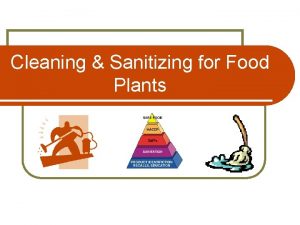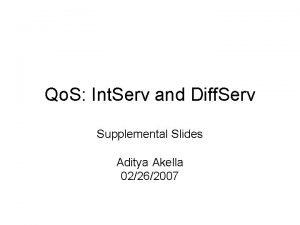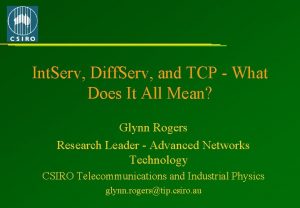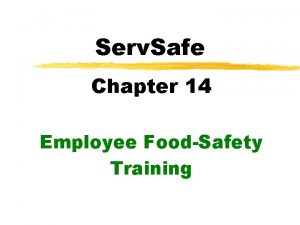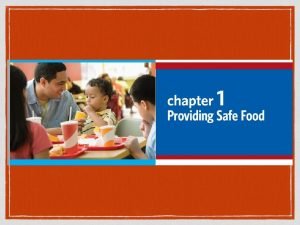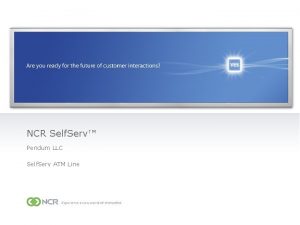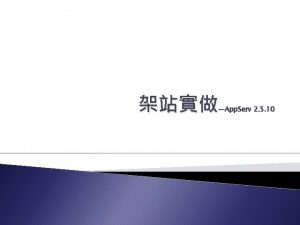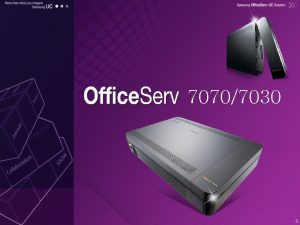Serv Safe Chapter 11 Cleaning and Sanitizing GOALS









































- Slides: 41

Serv. Safe Chapter 11 Cleaning and Sanitizing

GOALS TO FOCUS ON: z. Cleaning and Sanitizing z. Machine Warewashing z. Manual Warewashing z. Cleaning and Sanitizing Equipment z. Cleaning the Kitchen

z. Cleaning the Premises z. Tools for Cleaning z. Non-Food Storage z. Using Hazardous Materials z. Implementing a Cleaning Program

Objectives After completing this chapter you should be able to: z. Explain the difference between cleaning and sanitizing. z. Identify factors that affect the efficiency of sanitizers. z. Choose appropriate cleaners and sanitizers and safely store and handle them. z. Manually clean and sanitize tableware and equipment. z. Use proper machine warewashing techniques

Key Terms z Cleaning z Sanitizing z Cleaning Agent z Detergent z Solvent Cleaners z Abrasive Cleaner z Acid cleaner z Surfactants z Heat sanitizing z Chemical sanitizing z Sanitizer z Chlorine z Iodine z Quaternary ammonium compounds (Quats) z Sanitary z Hazard Communication Standard z Master cleaning schedule

Cleaning and Sanitizing Cleaning is the process of removing food and other types of soil from a surface such as a countertop or plate. Sanitizing is the process of reducing the number of microorganisms on that surface to safe levels.

Everything in your operation must be kept clean; however, any surface that comes in contact with food must be cleaned and sanitized. All food-contact surfaces must be washed, rinsed, and sanitized: z After each use. z When you begin working with another type of food. z Any time you are interrupted during a task and the tools or items you have been working with may have been contaminated. z At four-hour intervals if the items are in constant use.

Cleaning Factors That Affect the Cleaning Process z. Condition of soil z. Water Hardness z. Water Temperature z. Cleaning Agent and Surface Being Cleaned z. Agitation or Pressure z. Length of Treatment see Exhibit 11 a

Cleaning Agents Cleaning agents are compounds which remove food, soil, rust, stains, minerals, or other deposits. z Choose cleaning agents for specific cleaning properties. z Check with suppliers to find out which compounds are suitable for your needs z Cleaning agents must be stable, noncorrosive, and safe for employees to use. z Never combine compounds or attempt to make up your own cleaning agents.

Four Categories of Cleaning Agents z. Detergents z. Solvent Cleaners z. Abrasive Cleaners z. Acid Cleaners

Detergents Different types for all types of cleaning jobs. All detergents contain surfactants (surface acting agents) that reduce surface tension between the soil and the surface, so the detergent can quickly penetrate and soften the soil. The alkaline level varies.

Solvent Cleaners Often called degreasers, are alkaline detergents that contain a grease-dissolving agent. Acid Cleaners Acid cleaners are used on mineral deposits and other soil that alkaline cleaners can’t remove. Abrasive Cleaners Abrasive cleaners contain a scouring agent such as silica that helps scrub off hard-to-remove soils.

Sanitizing Two Methods that can be used to Sanitize surfaces. z. Heat Sanitizing- The higher the heat, the shorter the time required to kill microorganisms. z. Chemical Sanitizing- Effective, reasonably priced, and easy to use. Do not use any sanitizer on a food-contact surface unless it is EPA approved.

The three most common types of Sanitizers z. Chlorine z. Iodine z. Quaternary Ammonium Compounds (quats) see Exhibit 11 b

Factors Influencing the Effectiveness of Sanitizers z. Contact Time z. Selectivity (some may be more effective in their ability to kill certain microorganisms. ) z. Temperature (work best at temperatures between 75 degrees F to 120 degrees F. z. Concentration (use a test kit to check the concentration of a sanitizing solution. ) see Exhibit 11 c

Machine Warewashing They range in size from single-tank, stationary-rack machines to multi-tank flight-type machines. They sanitize by using either hot water or a chemicalsanitizing solution. z High-Temperature Machines- Final sanitizing rinse must be at least 180 degrees F. Stationary-rack single temperature machines, final sanitizing rinse must be at least 165 degrees F. z Chemical-Sanitizing Machines- Wash at no less than 120 degrees F. Rinse-water temperature should be between 75 and 120 degrees F.

The effectiveness of a warewashing program will depend on: z. Sufficient water supply z. A well-planned layout (see Exhibit 11 e) z. Separate area for cleaning pots and pans. z. Devices to indicate water pressure and temperature. z. Devices that automatically dispense detergent and sanitizer. z. Protected areas for clean tableware and utensils z. Trained employees.

All warewashing machines should be operated according to manufacturers’ instructions. General procedures to follow to clean and sanitize tableware, utensils, and related items. z Check and clean as often as needed. z Make sure detergent and sanitizer are properly loaded. z Scrape, rinse, or soak items before washing. z Load racks correctly and use racks designed for the items being washed. z Check temperature and pressure. z Check each rack after coming out of the machine. z Air dry all items. z Keep machine in good repair.

Manual Warewashing Three-compartment sinks are mostly required. A properly set up warewashing station will include: z. An area for scraping or rinsing off food. z. Drain boards to hold both soiled and clean items. z. A thermometer in each sink to measure water temperature. z. A clock with a second hand.

Follow these steps when washing and sanitizing all tableware, utensils, and equipment (see Exhibit 11 f) z. Step 1: Rinse, scrape, or soak z. Step 2: Wash (temperature 110 degrees F. ) z. Step 3: Rinse (temperature 110 degrees F. ) z. Step 4: Sanitize (If hot-water immersion is used, the water must be at least 171 degrees F. Some health codes require 180 degrees F. ) z. Step 5: Air Dry

Cleaning and Sanitizing Equipment Clean-in-place Equipment must be cleaned and sanitized every day unless otherwise indicated by the manufacturer.

Stationary Equipment in general, follow these steps: z. Turn off and unplug z. Remove food and soil z. Remove detachable parts z. Wash and rinse fixed surfaces z. Keep cloths used for food-contact and non-food-contact surfaces separate. z. Air dry all parts z. Resanitize food-contact surfaces that were touched putting parts back on

Refrigerated Units When cleaning and sanitizing, follow these suggestions: z. Clean before taking deliveries z. Move food to another unit before cleaning z. Wash, rinse, and sanitize shelves regularly

Cleaning the Kitchen floors, walls, shelves, ceiling, light fixtures, and drains. To clean floors, follow these steps: z Mark with signs or safety cones z Sweep first z Use a deck or scrub brush and full-strength detergents on heavy soiled areas z Mop or pressure-spray the area ywork from walls towards drain yclean a ten-foot by ten-foot area with both sides of mop. y. Use a figure-eight motion

z. Remove excess water z. Rinse thoroughly with clean water Walls and Shelves Clean tile and stainless-steel surfaces by spraying or sponging with a detergent solution.

Cleaning the Premises Tables z. When seating customers, remove extra tableware. z. Use a dry wiping cloth to clean crumbs and dry food spills. z. Use a moist cloth to clean up other types of food spills.

Serving Stations z. Clean up spills immediately z. Wash, rinse, and sanitize sinks and countertops at least daily or after each shift. z. Clean equipment daily or as often as recommended z. Wash, rinse, and sanitize bus tubs at least daily or after each shift.

Public Restrooms z Check public and employee restrooms regularly. z Restock soap, toilet paper, and towel supplies before they run out. z Clean sinks, mirrors, walls, floors, counters, dispensers, toilets, urinals, and waste receptacles at least daily. Use a separate set of cleaning tools. z Remove trash at least once daily, or as often as necessary. Exterior Premises Should be kept in good, clean condition.

Tools for Cleaning z. Brushes z. Scouring Pads z. Mops and Brooms

Non-Food Storage areas for cleaning supplies should be out of the way of kitchen traffic and potential cross-contamination Tableware and Equipment z At least six inches off the floor z Clean and sanitize trays and carts z Store glasses and cups upside down z Keep food-contact surfaces of clean-in-place equipment covered.

Cleaning Tools and Supplies z. Air dry wiping cloths overnight z. Hang mops, brooms, and brushes z. Clean, rinse, and sanitize buckets see Exhibit 11 g

Using Hazardous Materials Chemicals when used improperly, may become a health hazard that can cause injury. The Occupational Safety and Health Administration (OSHA) requires employers to comply with their Hazard Communication Standard (HCS). This standard, also known as Right-to-Know or HAZCOM, requires employers to tell their employees about chemical hazards to which they may be exposed to at the establishment.

A hazard communication program must include the following components: z. An inventory of hazardous chemicals z. Chemical labeling procedures y. Chemical name y. Manufacture’s name and address y. Potential hazards of the chemical

z. Material Safety Data Sheets (MSDS) y. Information about safe use and handling y. Physical, health, fire, and reactivity hazards y. Precautions y. Appropriate personal protective equipment (PPE) to wear y. First-aid information and steps to take y. Manufacturer’s name, address, and phone number y. Date the MSDS was prepared y. Hazardous ingredients and identify information

z. Employee training y. Existence and requirements of the Hazard Communication Standard y. How the hazard communication program is implemented y. Operations and processes where hazardous chemicals are used y. The inventory of chemicals y. The location of MSDS y. How to read the MSDS and product labels y. Physical and health hazards

y. Specific procedures adopted to provide protection y. Using PPE, and steps to prevent or reduce exposure to chemicals ysafety and emergency procedures y. Information on the normal use of chemicals

z. A written plan addressing hazard communication standards y. List of hazardous chemicals y. Purchasing specifications y. Procedures for receiving and storage y. Labeling requirements y. Procedures for accessing MSDS y. List of personal protection equipment (PPE) y. Employee training procedures y. Reporting and record-keeping procedures y. How the employer will inform employees of the hazards of nonroutine tasks

Implementing a Cleaning Program A cleaning and sanitary environment is a prerequisite to an effective HACCP- based food-safety program. Identify Cleaning Needs z. Walk through every area of the facility z. Look at the way cleaning is currently done z. Estimate the amount of time and what skills are needed for each task

Create a Master Cleaning Schedule Master cleaning schedule list all items that need to be cleaned and how often. see Exhibit 11 i z. What should be cleaned z. Who should clean it z. When it should be cleaned z. How it should be cleaned (see Exhibit 11 j)

Choose Cleaning Materials z Pick cleaning agents and tools according to the needs identified on the master cleaning schedule z Replace tools that are worn out z Provide employees with the right protective gear Training Employees z Schedule a kick-off meeting to introduce the program z Schedule enough time for proper training z Provide plenty of motivation

Monitoring the Program z Monitor completion of all cleaning tasks daily against the master cleaning schedule z Review the master schedule every time there is a change in menu, procedures, or equipment z Request employee input on the program during staff meetings z Conduct spot inspections
 What information should a master cleaning schedule contain?
What information should a master cleaning schedule contain? Strategic goals tactical goals operational goals
Strategic goals tactical goals operational goals Strategic goals tactical goals operational goals
Strategic goals tactical goals operational goals Final sanitizing rinse temperature
Final sanitizing rinse temperature Unsafe food temperature range
Unsafe food temperature range Safe feed safe food
Safe feed safe food Safe people safe places
Safe people safe places General goals and specific goals
General goals and specific goals Examples of generic goals and product-specific goals
Examples of generic goals and product-specific goals Atradius serv net
Atradius serv net Int serv
Int serv Derivserv
Derivserv Serv definition
Serv definition Rekeszizom sérv
Rekeszizom sérv Rsvp ejemplos
Rsvp ejemplos Apa serv alexandria
Apa serv alexandria How to use brutus password cracker
How to use brutus password cracker Ship serv
Ship serv Chapter 15:2 bioterrorism
Chapter 15:2 bioterrorism Chapter 15:3 washing hands
Chapter 15:3 washing hands Chapter 8 healthy peer relationships
Chapter 8 healthy peer relationships Chapter 8 healthy peer relationships
Chapter 8 healthy peer relationships Motorist
Motorist Chapter 4 safe driving rules and regulations
Chapter 4 safe driving rules and regulations Chapter 4 safe driving rules and regulations
Chapter 4 safe driving rules and regulations Chapter 4 safe driving rules and regulations
Chapter 4 safe driving rules and regulations Chapter 8 lesson 1 safe and healthy friendships
Chapter 8 lesson 1 safe and healthy friendships Data cleaning problems and current approaches
Data cleaning problems and current approaches Clean public areas, facilities and equipment
Clean public areas, facilities and equipment Cleaning and maintaining kitchen premises
Cleaning and maintaining kitchen premises Data quality and data cleaning an overview
Data quality and data cleaning an overview Data quality and data cleaning an overview
Data quality and data cleaning an overview Data integration in data preprocessing
Data integration in data preprocessing Cleaning and sanitation manual for breweries
Cleaning and sanitation manual for breweries What the things you in cleaning kitchen premises
What the things you in cleaning kitchen premises Cleaning the tides of san diego and tijuana
Cleaning the tides of san diego and tijuana Chapter 2 keeping food safe
Chapter 2 keeping food safe Potentially hazardous food is usually moist
Potentially hazardous food is usually moist The world's constable cartoon explained
The world's constable cartoon explained In keeping equipment and facilities safe and sanitary
In keeping equipment and facilities safe and sanitary Tru count air clutch installation manual
Tru count air clutch installation manual Power tool cleaning
Power tool cleaning
